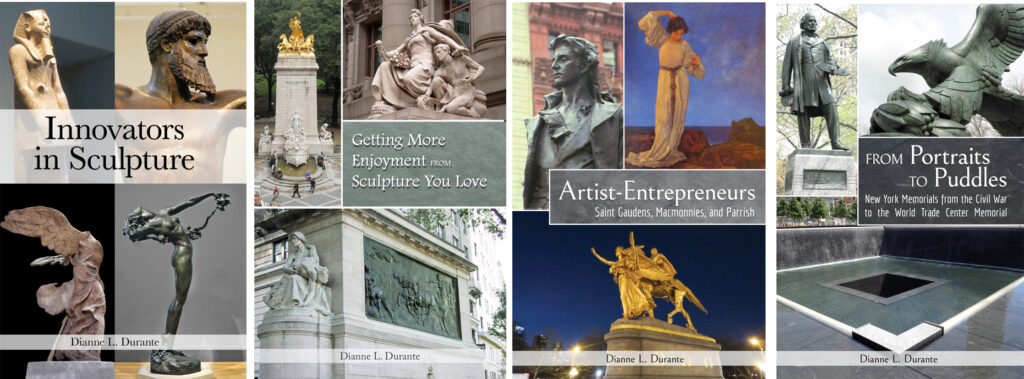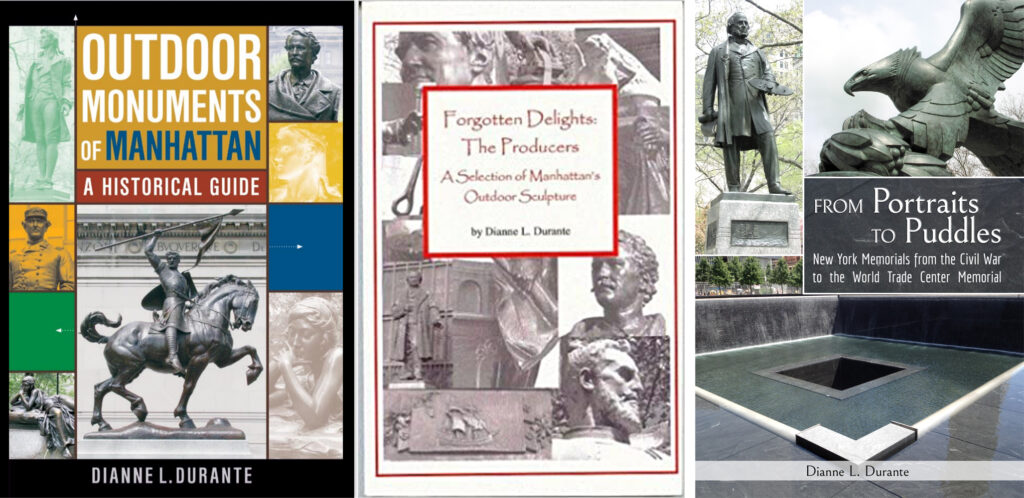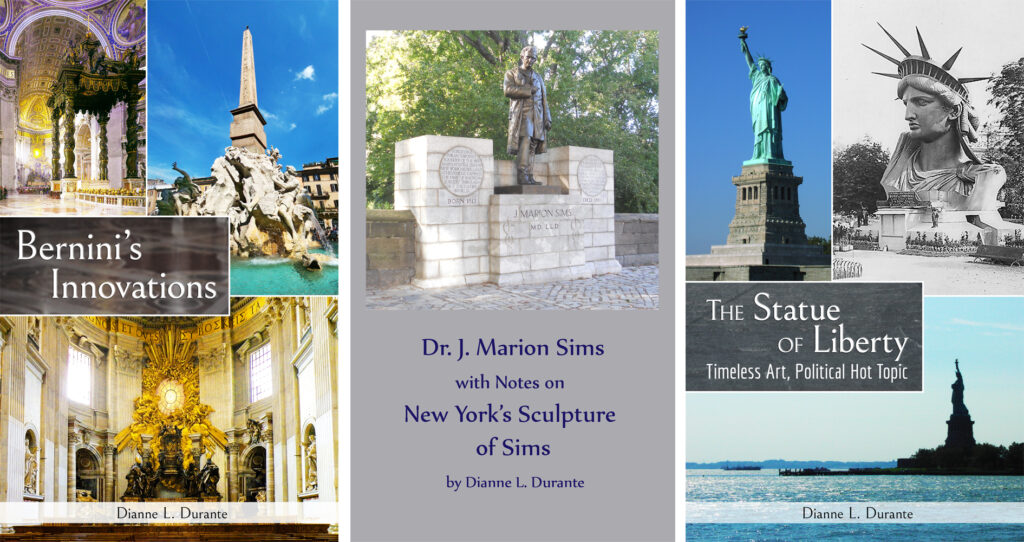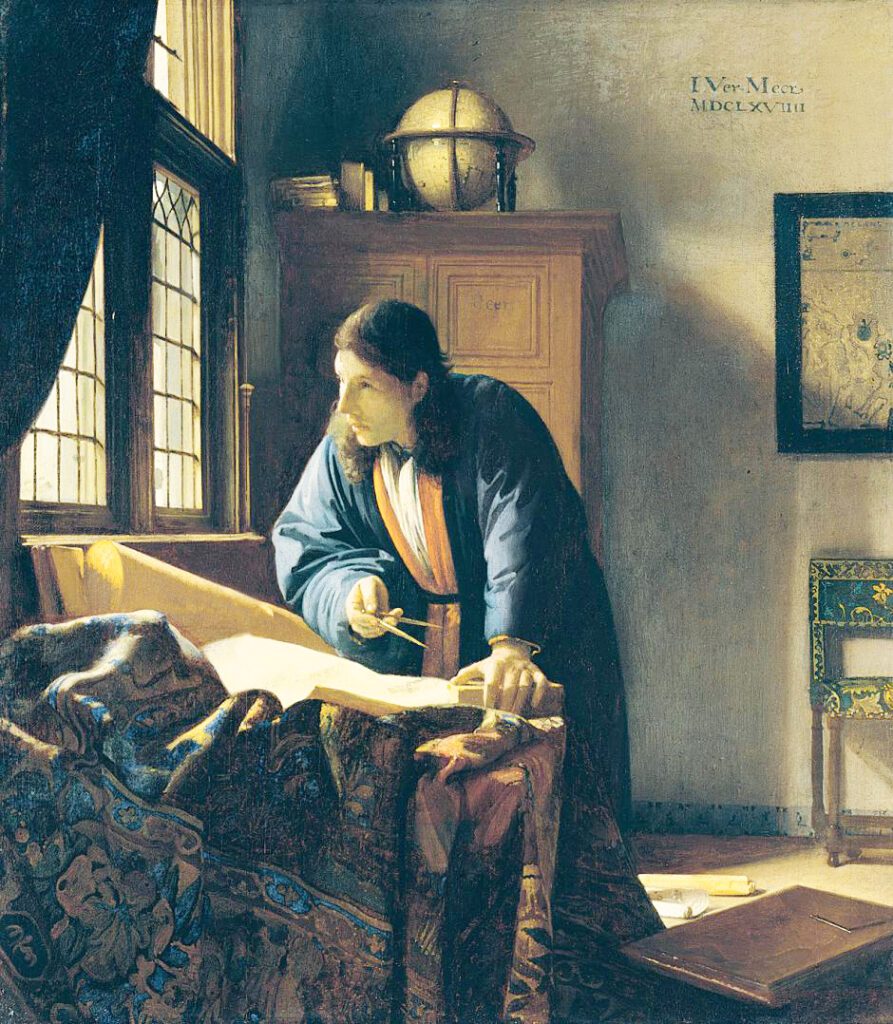This page includes Sculpture, Painting, Opera, Literature, and Movies & TV. There are separate pages on this site for my writings on Alexander Hamilton; History, technology, and business; Writing, copywriting, and publishing; and Fearless Foreign Foods. For book recommendations for kids, see this page; for music and toys for kids, see this page.
- On looking at art, see the page “How to go from a gut reaction to thinking about art – and why bother?“
- On the nature of art (very down-to-earth and commonsensical, I promise): see Innovators in Sculpture, particularly Chapter 1, Chapter 3 point 3, Chapter 8 points 1 & 2, Chapter 9 sections 1-2, and Chapter 12 section 6.
Sculpture

- Innovators in Sculpture. Click here for more information.
- Getting More Enjoyment from Sculpture You Love is available on Amazon in print and Kindle formats. More here. A favorite artwork can provide you with enjoyment and inspiration, help you recall important events of the past, and help you project a course into the future. Get even more enjoyment from a work of art you love by approaching it with an active mind: studying its details and asking questions about its meaning.
- “How to Introduce Your Kid to Art” (Medium.com): Advice from a former homeschooling parent and current art historian.
- Artist-Entrepreneurs: Saint Gaudens, MacMonnies, and Parrish: During the late 19th and early 20th century, the most capitalistic era in American history, it was considered normal that the immense popularity of Augustus Saint Gaudens, Frederick MacMonnies and Maxfield Parrish should earn them substantial wealth. This is a brief overview of the life and notable works of three artists, within the historical, political, and economic framework of the period between the Civil War and World War I.
- From Portraits to Puddles: New York Memorials from the Civil War to the World Trade Center Memorial (Reflecting Absence) (available in print and ebook): Surely we can offer the victims of 9/11 a better tribute than Reflecting Absence, a gloomy piece of landscape architecture with lists of names. But what makes an effective tribute? What makes a memorable memorial?
- “The 2005 Turner Prize: English Art in Plain American“: A rant on Artspeak.
- “Cave Paintings and Christo’s Gates: Art in Individual Minds and Public Places“: A discussion of why Christo’s Gates shouldn’t have been installed in Central Park (published before the installation opened). Video here.
- On photographing sculpture, see “Tips for Photographing Sculptures“. For my favorites among the thousands I’ve taken, see the category Photography.
New York Sculptures
- On controversial outdoor sculptures: “Politics and Portrait Sculptures,” blog post, video, and printable PDF. For several guest posts on the topic, click Sculpture Controversy in the Obsessions cloud.
- Here’s how I got interested in this niche market: “Carving Out an Unlikely Writing Niche“.
- On early sculptures in Central Park, see Central Park: The Early Years. Also try clicking the Central Park tag in the Obsessions cloud.
- For sculptures of Hamilton, see Alexander Hamilton: A Brief Biography.
- Monuments of Manhattan (Guides Who Know videoguide app for Android and iPhone) – A series of 4-minute videos on 55 of the most beautiful and/or intriguing outdoor sculptures in Manhattan; with details of the sculptures, archival images, maps, and animations, plus original music, GPS, and HopStop directions. Based on my book Outdoor Monuments of Manhattan: A Historical Guide.
- “Creating the Monuments of Manhattan app” (interview with Marion Calabro for Freewrite ezine)
- Interview on Monuments of Manhattan app (with Joseph Kellard in The Objective Standard)
- Outdoor Monuments of Manhattan: A Historical Guide (hardcover & paperback) – 54 monuments, ranging from major figures in American history to city icons, and with works by some of America’s best sculptors. Each monument has an “About the Subject” and “About the Sculpture” section.
- Forgotten Delights: The Producers (paperback) – First in a what was intended to be a series of self-published books on outdoor sculptures in Manhattan; includes essays on explorers, inventors, engineers, businessmen, and workers, some of which I still haven’t published anywhere else.
- On the World Trade Center Memorial: From Portraits to Puddles: New York City Memorials from the Civil War to the World Trade Center (Reflecting Absence). Surely we can offer the victims of 9/11 a better tribute than Reflecting Absence, a gloomy piece of landscape architecture with lists of names. But what makes an effective tribute? What makes a memorable memorial? The sculptures in nearby Battery Park provide excellent examples of memorials dedicated over the past hundred years. In this essay, I point out lessons from half a dozen of them that can be applied to a memorial for the World Trade Center – and I explain how our memorials declined from portraits to puddles.

Specific artists & sculptures
- Bernini’s Innovations (Kindle) – Innovations by Bernini that changed the history of sculpture, followed by a brief chronological survey of this Baroque sculptor’s life and major works; with dozens of color illustrations.
- Dr. J. Marion Sims, with Notes on New York’s Sculpture of Sims (Kindle): A look at the controversial career of Dr. J. Marion Sims, “the Father of Gynecology,” and the sculpture of him at Fifth Avenue and 103rd Street, New York City.
- Alexander Hamilton: A Brief Biography (Kindle) – details on the four sculptures of Hamilton in Manhattan; see here.
- “MacMonnies’ Nathan Hale” – “MacMonnies’ Nathan Hale is a reminder not of what the Founding Fathers stood for, but of how they stood for it. …”
- The Statue of Liberty: Timeless Art, Political Hot Topic (Kindle) – A look at the Statue of Liberty as a timeless work of art and as a political statement by those who conceived it and by their contemporaries in the late 19th century. Includes archival illustrations, close-up views of Liberty, quotes from sculptor Bartholdi and his contemporaries, and tips on photographing outdoor sculptures in New York.

Painting
- Innovators in Painting (now available in print and as an ebook) uses innovations as a framework for an overview of the history of Western art. It’s a great introduction or refresher for anyone interested in art or art history. The broadest goal is to help you find more subjects, styles, and periods that intrigue you and appeal to you – that present the world the way you think it can and ought to be. Because what’s the point of looking at art, if not for moments like that? More here. It’s a stand-alone work, but a perfect companion to Innovators in Sculpture.
- How to Analyze and Appreciate Paintings (Kindle) – Via discussions of Holbein’s Sir Thomas More and Bellini’s St. Francis in the Desert, we work through a series of questions to help you systematically observe the details of a painting, state what effect they have, and set them in the context of the rest of the work. As we go, we work out tentative themes and then a final statement of the theme; and finally, we evaluate the works in emotional, esthetic, philosophical, and art historical terms.
- “How to Introduce Your Kid to Art” – advice from an art historian who’s also a former homeschooling parent.
Genres and periods
- “Landscapes: History and Significance“ – Landscapes have often been rated second-class compared to history and narrative paintings. How did this attitude develop, and what message or meaning can landscapes offer?
- “Still Lifes: History and Significance“ – At the famous Salon exhibitions in 19th-c. Paris, a mediocre mythological painting would have been displayed more prominently than the most exquisitely composed and executed still life. Why were still lifes considered second-class art for centuries? Is there an objective reason to rate them unfavorably vs. paintings that incorporate human figures?
- Seismic Shifts in Subject and Style: 19th-c. French Painting and Philosophy (Kindle) – What caused the dramatic shifts in subject and style over the course of the 19th century – from Madame Recamier, by Jacques-Louis David (1800), to Luxe, Calme, et Volupte, by Matisse (1904)? This 30,000-word essay is a combination of art analysis and philosophical detection.
Specific works
- “Vermeer’s Geographer“ – “Think of a moment of insight – a moment when you had an integration of such scope that it made you stop writing, stop speaking, stop moving, so you could concentrate on working through the implications of that thought. What would you give for a reminder of that moment when you were tired, or had writer’s block, or when you just needed to remember that one man improves, and the whole of mankind progresses, by such moments of insight? …” Video here.
- “Comments on Tim’s Vermeer “- Did Vermeer uses a lens and a concave mirror to project an image onto the canvas, which he then painted?

Opera
- Review of Amor and Psyche, performed by Opera Feroce
- Review of Arminio in Armenia, performed by Opera Feroce
- For blog posts on specific works, see the Music and Opera categories.
Literature
- Starry Solitudes, A Collection of Inspiring and Thought-Provoking Poetry, ed. Dianne L. Durante, 2022.
- Henry Kitchell Webster, Collected Short Works and Related Correspondence, edited by Dianne L. Durante using material from the Webster archives at the Newberry Library. Includes all his short stories, many of which were only published once, in periodicals (1901-1932).
- “Amadeus Revisited” – For 20 years, I refused to watch Amadeus because I couldn’t stand the way Mozart was represented (with excerpts from Pushkin!). When I finally did watch it again, I realized I’d been misinterpreting it.
- “Vitamins, Minerals, and Harry Potter” – The Harry Potter stories, by depicting a world in which good triumphs over evil, give us strength to face real enemies.
- Review of The Scarlet Pimpernel (Broadway play) – Here’s why I loved the first version – although I’d be happy to see any of the versions again.
- For blog posts on specific works, see the Categories Fiction, Literature, and Poetry.
Movies & TV
- “Movie Reviews and How to Write Them” (part 1 of 3) – Thinking through how to write reviews, with Chronicles of Narnia as a sample.
- “Best Picture: Says Who?” (part 2 of 3) – On the Academy Awards
- “Analyzing and Evaluating Films as Works of Art” (part 3 of 3) – Standards for judging films esthetically
- Comments on Tim’s Vermeer – Did Vermeer uses a lens and a concave mirror to project an image onto the canvas, which he then painted?
- “Amadeus Revisited” – For 20 years, I refused to watch Amadeus because I couldn’t stand the way Mozart was represented (with excerpts from Pushkin!). When I finally did watch it again, I realized I’d been misinterpreting it.
- “Buffy the Vampire Slayer and the Real World” – “Why do I feel the Hellmouth is gaping because Buffy the Vampire Slayer’s last episode airs this month? After all, I have no immediate, ‘practical’ reason for watching it. I don’t need lessons in killing demons, or martial arts, or dressing twenty-chic. So what’s the appeal? …” (A thank-you of sorts to Joss Whedon.)
- For blog posts on specific works, see the category Film.
More
- Want wonderful art delivered weekly to your inbox? Check out my free Sunday Recommendations list: details on it, and on becoming a paid supporter, are here. I do not share my mailing list with anyone, ever.